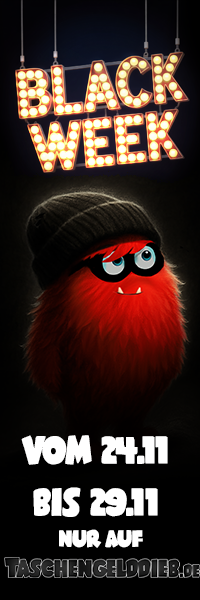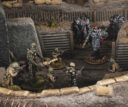Konflikt ‘47: Stahltruppen Spotlight
Es gibt ein weiteres Preview zu Konflikt ’47.
Konflikt ‘47 – Stahltruppen Spotlight
Even before the opening of the Rifts, all of the major belligerents of the Second World War had conducted significant experimentation with infantry body armour, seeking to reduce the number of gunshot and shrapnel deaths, particularly from shell splinters and close-quarters fighting. The Soviets had long issued their assault engineers with the simple SN-42 steel breastplate, which was reasonably effective but cumbersome and unpopular, while the Americans had developed the so-called ‘flak jacket’ for their bomber crews and sailors.
None of these designs were truly satisfactory in reducing combat casualties. They were certainly better than nothing, but their weight and inconvenience often led to soldiers discarding them in favour of increased mobility and a reduced load. What was needed was nothing short of a modern suit of plate armour, strong enough to resist incoming fire but well-fitted and lightweight enough to not overly impede a soldier’s combat movement. Until the opening of the Rifts, however, there was simply no such technology in existence.
With the advent of Rift-tech, Axis scientists foresaw the need for improved protection for the average infantryman and almost immediately began working towards this end. The first experiments were crude in the extreme – little more than steel plates bolted to a crude exoskeleton, with a small gasoline engine and hydraulic system derived from light aircraft for motive power. Halting and clumsy in their movements, and enormously heavy, they were impossible to wear for long periods of time but proved the basic concept of an armed man almost completely enclosed in armour plate.
Steel on steel! Stahltruppen face off against Automated Infantry.
The first Rift-tech breakthrough for the programme came in the form of a new powerplant, smaller and more lightweight than before but offering far greater power. This enabled the wearer to move far more quickly than before, and the first prototypes of what was dubbed Panzerharnisch 44, in reference to the armour of medieval knights, began field trials in early June 1944. As Commonwealth and US forces began to push inland after D-Day, they had their first encounters with these testing units, and it quickly became apparent that the design had real merit. Though slow, the Axis heavy troopers proved all but impervious to small arms, and the sight of their grinding advance through storms of machine-gun fire had a significant impact on Allied morale.
With the field trials a qualified success, the project split into two distinct lines. One focussed on designing smaller, lighter armoured suits, suitable for issue en masse, and the other pursuing the development of ever larger and heavier ‘breakthrough’ suits. The former would see great success, resulting in the Panzerharnisch 46 suits in widespread use with the Axis Schwertruppen divisions – capable, well-rounded formations forming the backbone of many Axis formations across Europe. The latter would follow a rather more winding path, and end in something much, much larger…
The ‘heavy’ team, formed as Projekt Stahl, theoretically had a simpler task than their colleagues. Rift advances in metallurgy enabled armour plate and exoskeleton framing to be made lighter and more effective, while several breakthroughs in the miniaturisation of servo-motors and hydraulic systems provided a reliable, lightweight propulsive unit. The basic design coalesced into a monstrous suit into which a man stepped, rather than donned. Raising the wearer to almost eight feet in height, and capable of mounting a wide range of heavy weaponry, it was considered a highly successful piece of equipment, almost ready for the field by late 1945.
Just as Projekt Stahl seemed poised for deployment, the Byzantine politics of Axis senior leadership intervened. From the outset, the new Schwere Panzerharnisch had been destined for the Panzergrenadier divisions, to be issued in small numbers to spearhead assaults on heavily defended positions. However, the rapid development of Rift-tech enhanced units in the Axis order of battle had led to a significant reshuffling of military responsibilities, and a bitter power struggle for control of the new units developed between the infantry – the originally intended users – and the artillery. The leadership of the artillery branch advanced the somewhat tenuous claim that, as they were intended for breakthrough actions, they were analogous to assault guns, and should therefore be incorporated into their command structure.
While Axis commanders bickered over which branch would control the new troops, Projekt Stahl had stalled almost completely, as funding and supplies were cancelled, approved, and cancelled again. It was not until mid-1946, when the artillery finally won out, that final approval was granted to begin production, with the first units reporting for training and re-equipping by September of that year. By this stage, the other belligerent nations had begun to deploy troops in powered armour of their own, but none had the sheer size of the new Axis suits.
The initial combat deployment of the new troops, dubbed Stahltruppen, came in Poland in December 1946. Advancing Soviet forces, expecting to overrun what their intelligence had marked as an Axis artillery regimental HQ, were stunned by the appearance of the gargantuan heavy infantrymen instead. The Stahltruppen counterattacked from concealment in a wooded area, meeting a force of Soviet infantry head-on. The Soviets, veterans of the brutal Eastern Front, were annihilated in minutes, their weapons unable to do more than chip the paint of the massive armoured infantrymen. A follow-up attack by tanks was similarly destroyed, and the Soviet commander withdrew his forces, claiming the existence of a new ‘super-weapon’.
Soviet forces encounter the full weight of the Axis.
Following the initial success, Stahltruppen production was assigned the highest priority by the Green Vault, and more and more suits were rapidly sent both to the Eastern Front and westwards. The units quickly gained a reputation for brutal efficiency and terrifying attacks, seemingly walking through the heaviest enemy fire with slow, inexorable steps. The men of the Stahltruppen units, selected from the finest soldiers from across the Axis, rightly came to view themselves as a cut above all other troops, although this quickly manifested as an institutional arrogance and unshakeable belief in their own superiority.
1947 sees the Stahltruppen wherever the fighting is thickest. Deployed in small numbers to lead the most critical assaults or defend positions that must not be allowed to fall, their arrival on the battlefield means that the fighting is about to intensify exponentially. This, coupled with their often aloof nature, means that their presence is seen as a mixed blessing by many ‘regular’ Axis forces, but their combat prowess is undeniable. Axis propaganda and enemy intelligence reports alike agree that, when employed at the right time and in the right place, even a small number of Stahltruppen can turn the tide of battle. Initially jealously guarded by the artillery, the Green Vault leadership appears to have run out of patience with this particular squabble, and Stahltruppen can now be found bearing the colours of multiple branches of the Axis military.
Stahltruppen spearhead the Axis assault!
The Schwere Panzerharnisch suits allow each man to carry a wide range of weaponry, from the compact and lethal StG 44Z double-barrelled assault rifles and MG 44 light machine-guns to the deadly Panzerbüchse 45 anti-tank gun, hefted as easily as a normal man might hold a rifle. These give the Stahltruppen the ability to counter both enemy infantry and armour, and are supplemented by shoulder-mounted Panzerfaust anti-tank rockets and grenade launchers, and wicked tri-edged fighting daggers, as well as the brute strength of the suits themselves.
On the Konflikt ‘47 tabletop…
Axis Stahltruppen are (for now!) the heaviest infantry in the game. Boasting a massive 7+ Damage Value and the Augmented special rule, they’re impervious to small arms fire and can fire their heavy weaponry without the need for loaders, while their Vormarsch! Active Rift Ability allows them to Exhaust their Rift Die to automatically pass their Order Check and discard all Pin Markers when given an Advance order. This ensures that, no matter how much incoming fire they’re taking, your Stahltruppen will keep grinding forwards, eager to bring the hammer of the Green Vault down on the enemies of the Axis.
The new plastic sprue lets you bring the Stahltruppen and all of their weapons options to life on the table, with three of these hugely bulky and detailed models per frame. With multiple leg options to ensure maximum variety of poses, and a wide range of weapon arms and heads, you can customise your units to your exact specifications. The sheer size of the Stahltruppen makes them instantly recognisable centrepiece models to any Axis force, and their broad armour plates lend themselves to a huge variety of painting techniques. Will you apply all your vehicle-painting knowledge to create weathered slabs of metal, or go ham on the camouflage to produce unique units optimised for a specific theatre? The choice is yours!
Heavy duty! The sprue is packed with options.
A canny Axis commander will recognise the immense power of the Stahltruppen to bully units without heavy or Rift weaponry and mow down unarmoured infantry. These elite troops carry a hefty points cost and are relatively few in number, so their proper positioning is essential. Their armour, while monstrously thick, can still be penetrated by heavy weaponry, so commanders will have to ensure they’re well supported to allow them to fulfil their incredibly destructive potential on the table.
Quelle: Warlord Games










Zweimal dieselben Bilder hintereinander. Denk mal daserste ist falsch weil da keine Sowviets drauf sind.
Die neuen Kits von Konflikt 47 sehen echt gut aus. Die Stahltruppen haben viel Potential für Umbauten und machen durchaus was her.
Von den Helmen passen die perfekt zu den Eisenkern Truppen.
Bin mal gespannt ob die von der Größe passen, das wäre prima.
Wenn man da andere Hüte drauf macht und vllt. andere Knarren ausgibt sind das auch coole generische scifi/x-punk Typen.
Das sieht ziemlich cool aus und ich wäre geneigt einzusteigen. Aber das Timing ist gerade leider schlecht mit StarCraft am Horizont. Archon liefert was Qualität und Preis angeht bis jetzt immer ab.
Hm….hat schon auch sehr was von den Schweren Grenadieren (L4 inf) der Achse bei DUST. Klar, viele Variationen sind schwer in das Thema zu bringen aber beim re-release springt es mich gerade irgendwie an.
Tolle Modelle die für eine Vielzahl von Systemen einen guten Einsatz findet.